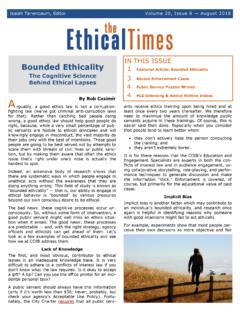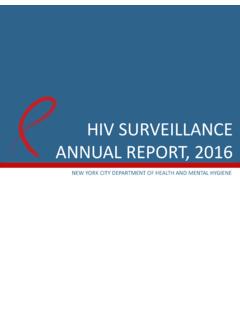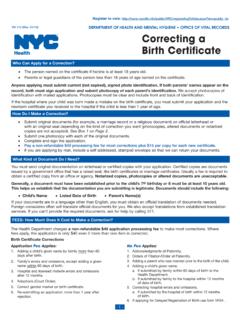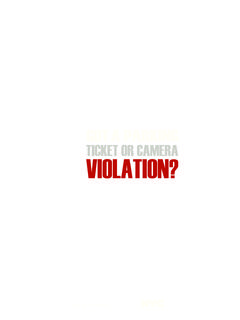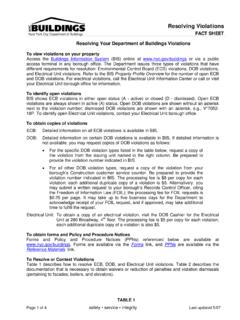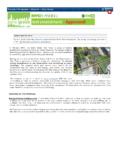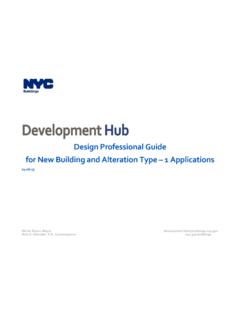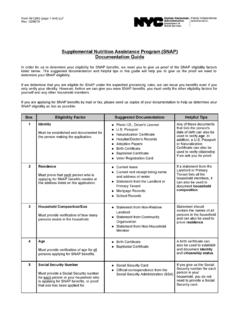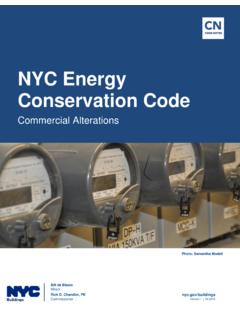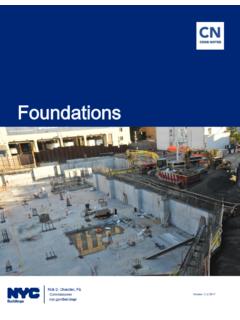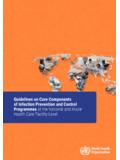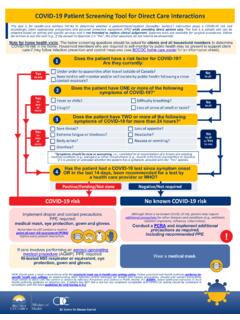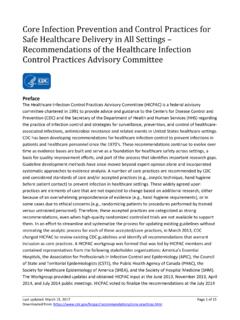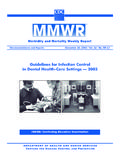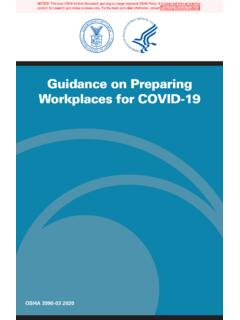Transcription of COVID-19 Outpatient Infection Control Quick Guide
1 1 covid - 19 outpatient infection control Quick Guide Strict adherence to Infection Control procedures is critical to preventing transmission of COVID-19 , including potential transmission from people with asymptomatic or presymptomatic Infection . The following recommendations are designed to help facilities ensure appropriate precautions are in place to protect patients and staff from exposure to COVID-19 and other viral respiratory infections during periods of ongoing community transmission. These recommendations apply regardless of staff and patient vaccination status. Minimize unnecessary exposures in the health care setting. Screen all patients, accompanying companions and visitors for symptoms or exposure to COVID-19 in the past 14 days, ideally prior to entering the facility. Perform an initial evaluation of patients with fever and other acute symptoms remotely via telephone or video when possible.
2 O Consider referring patients who require COVID-19 testing but no immediate in-person medical care to COVID-19 testing sites to prevent exposure in other clinical spaces. Advise patients with covid -like illness (CLI)1 who need in-person assessment to take precautions when traveling to and arriving at the clinic (for example, wear a face covering, avoid public transportation if possible, immediately notify staff when they arrive). Encourage patients with and without CLI to come to the facility alone, if possible, to better enable physical distancing and reduce potential exposure to COVID-19 . Consider having specific hours and teams to see patients with CLI and to test for COVID-19 . Schedule these visits later in the day, if possible, before cleaning and disinfection. Utilize COVID-19 staff teams with dedicated rooms/areas to minimize exposure risks and maximize supplies of personal protective equipment (PPE).
3 Ensure universal source Control . Everyone entering the facility over age 2 should wear a well-fitted face covering since they could potentially have COVID-19 even without showing symptoms. o Have a supply of face masks or coverings ready to provide to people entering the facility, if needed. All staff should wear a well-fitted face mask or respirator at all times while working in a health care setting. 1 covid -like illness (CLI): people with COVID-19 can have a range of mild or severe symptoms including cough, shortness of breath or difficulty breathing, fever, chills, muscle pain, sore throat, congestion or runny nose, or new loss of smell or taste, nausea, vomiting and diarrhea. Older patients may present with atypical signs or symptoms, such as delirium or falls. 2 Refer to the Centers for Disease and Control and prevention (CDC) s Infection prevention and Control guidance for Healthcare Professionals During Coronavirus ( COVID-19 ) for more details on appropriate source Control .
4 Implement measures to ensure physical distancing in entryways, waiting rooms and staff areas. Use methods such as signs, chair arrangements, floor markers indicating 6 feet of distance, single direction staircases and elevator capacity limits. Emphasize to staff and post signs on the importance of maintaining mask use and physical distancing in staff-only areas, including break rooms. Follow current PPE recommendations. When evaluating or coming into prolonged close contact2 with patients with suspected or confirmed COVID-19 , the New York City Department of Health and Mental Hygiene (NYC Health Department) recommends the following PPE: o Fit-tested N95 (or equivalent or higher-level) respirator approved National Institute for Occupational Safety and Health (NIOSH), gown, gloves and eye protection (face shield or goggles) A fit-tested N95 respirator (or equivalent or higher) should be used for any potentially aerosol-generating procedures (for example, nebulizer treatments) or surgical procedure that might pose higher risk for transmission if the patient has COVID-19 (for example, involving anatomic regions where viral loads might be higher, such as the nose and throat, oropharynx, respiratory tract) For all other clinical encounters, health care workers should wear eye protection3 and one of the following.
5 O An N95 respirator or o A respirator approved under standards used in other countries that are similar to NIOSH-approved N95 respirators or o A well-fitting facemask (including face masks with a nose wire to help conform to the face; facemasks with ties rather than ear loops; use of mask fitters; tying the facemask s ear loops and tucking in the side pleats; and fastening the facemask s ear loops behind the wearer s head). CDC has created an FAQ addressing use of two masks at the same time in a healthcare setting. Have staff self-monitor for fever and symptoms of COVID-19 . Staff should monitor for fever and symptoms at least daily before each shift and immediately exclude themselves from duty and isolate if CLI symptoms develop. 2 Until more is known about COVID-19 transmission risks, the CDC recommends using the following definition of prolonged close contact: a cumulative exposure in a health care setting of 15 minutes or more during a 24-hour period without appropriate PPE.
6 3 For facilities in areas with moderate to substantial community transmission, the CDC recommends eye protection for staff in addition to face coverings to ensure the eyes, nose and mouth are all protected from splashes and sprays of infectious material from others. For more information, visit 3 o Refer to NYC Health Department s decision support tool if staff report symptoms of CLI within 3 days of receiving a COVID-19 vaccination. Any staff with CLI should be referred for diagnostic testing, preferably using a molecular-based test. o If an antigen test is used, a negative result should be confirmed by a lab-based molecular test. o Serologic (antibody) tests should not be used to diagnose acute COVID-19 , nor to determine immune status to SARS-CoV-2 (the virus that causes COVID-19 ). Give instructions for self-isolation to staff with a positive COVID-19 diagnostic test or for quarantine after a known exposure to a person diagnosed with COVID-19 .
7 New York State (NYS) requires health care workers with confirmed or suspected COVID-19 to self-isolate for at least 10 days from symptom onset, be fever-free for the prior three days without the use of antipyretics, and have an overall improvement in their illness (if symptomatic). NYS requires health care workers who have been exposed to a confirmed or suspected case of COVID-19 to quarantine for 10 days after the date of last exposure unless they are fully vaccinated4 or have had and recovered from a confirmed SARS-CoV-2 Infection within the past three Staff who are unable to safely isolate or quarantine at home (for example, they have high-risk household contacts or a living space that does not enable separation) may be eligible for a free hotel room through the NYC Test & Trace Corp. Check regularly for updates to Infection Control , testing and quarantine guidance .
8 Recommendations will continue to evolve as we learn more about the impact of COVID-19 vaccines and emerging variants on transmission. Updated NYC Health Department recommendations will be shared through the NYC Health Alert Network or through updated guidance on the NYC Health Department COVID-19 provider page. Remember that PPE is only one element of an Infection Control program designed to keep staff and patients safe. The Infection Control program should include source Control , rapid identification and isolation of symptomatic staff and patients, strict adherence to respiratory and hand hygiene practices, training staff on correct use of PPE, and rigorous environmental cleaning and disinfection of surfaces and equipment. The NYC Health Department may change recommendations as the situation evolves. 4 A person is considered fully vaccinated two weeks after their second dose in a 2-dose series, such as the Pfizer or Moderna vaccines, or two weeks after a single-dose vaccine, such as Johnson & Johnson s Janssen vaccine.
9 5 Three months after the date of symptom onset from the initial COVID-19 Infection or date of first positive diagnostic test if asymptomatic during illness. 4 Outpatient Facility Infection Control Recommendations Setting Scenario / Considerations Patients and Visitors Clinical Staff Non-Clinical Staff All areas Practice universal source Control Face mask or other face covering Face mask or respirator Face mask or respirator Entry Staff screening patients for CLI upon entry to the facility or clinic Face mask or other face covering Face mask or respirator Eye protection Face mask or respirator Eye protection Registration and waiting areas Creating a safe physical environment - Optimize physical distancing and engineering controls, such as air flow and installing barriers to limit direct contact Face mask or other face covering - Immediately place any patient with CLI or recently exposed to COVID-19 alone in private room with door closed Face mask or respirator Face mask or respirator Exam room Place patient with CLI or recent exposure to COVID-19 in a private room with door closed.
10 Initial evaluation of patient with confirmed or suspected COVID-19 Face mask or other face covering Fit-tested N95 (or equivalent) Eye protection Gown (if close physical contact) Gloves Avoid entering the room - Use face mask or respirator, eye protection and gloves if entry required Patient determined to be low suspicion for COVID-19 Face mask or other face covering Face mask or respirator Eye protection Face mask or respirator Eye protection Specimen collection for COVID-19 testing (nasopharyngeal) - Consider patient self-collected nasal swab or saliva if appropriate Face mask or other face covering; only remove for specimen collection Fit-tested N95 (or equivalent) Eye protection Gown Gloves Do not enter room during procedure Performing potentially aerosol-generating procedures ( , nebulizer treatment) - Avoid whenever possible - Consider safer alternatives ( , metered dose inhaler with spacer) Face mask or other face covering; only remove when necessary for treatment Minimize close contact (<6 feet) Fit-tested N95 (or equivalent) Eye protection Gown Gloves Do not enter room during procedure and for up to two hours Patient care areas Environmental Cleaning Room cleaning after a patient with possible COVID-19 vacates room - Can enter room immediately after patient leaves unless an aerosol-generating procedure performed.
